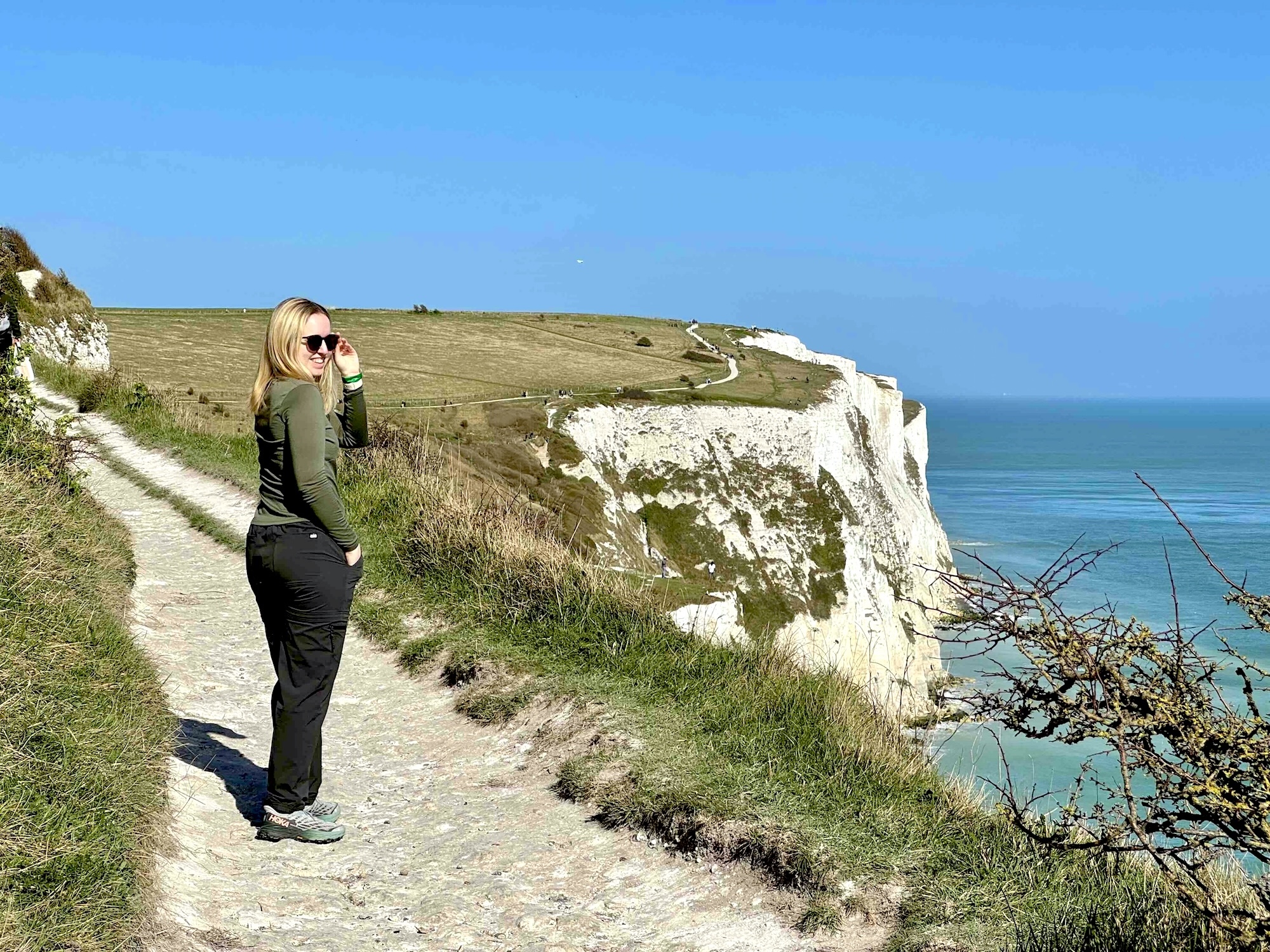London to Dover Day Trip – Soak up the Beautiful Seaside
London is such a great hub for day trips, especially given the fantastic transportation system that can quickly whisk you to so many places around the country. Dover, England sits on the English Channel, the closest city to France across the water. While Dover is famous for its iconic White Cliffs, it’s location has been of strategic importance for centuries, so there’s a great combination of history and nature to explore.
This London to Dover day trip was actually our first excursion outside the city after moving to UK! We lucked out with incredible weather in late March with sunny skies and moderate temperatures. This day trip was actually planned only 2 days out, so we already knew the forecast was looking good before we purchased tickets.
This post may contain affiliate links, which means I’ll receive a commission if you purchase through my link, at no extra cost to you.
How to Get from London To Dover
By Train
To get to Dover, we took the Southeastern train from St. Pancras to Dover Priory. Southeastern is the train operator, but be careful when booking because they have trains that take 1 or 2 hours depending on the number of stops. We opted for the faster high speed train to maximize our time in Dover.

I recommend using Trainline to search for trains as they aggregate all operators. However, you will save a little bit of money by booking directly with the train operator, avoiding Trainline’s £5 booking fee for a return ticket.
Also, booking in advance is cheaper than last minute. Running a search on Southeastern’s website for 3 weeks out, a high speed “super off-peak” round trip ticket would run you about £36 per person, but we booked just 2 days out and paid £43 per person.
When we visited in March 2025, there was an interruption in the train line at Folkestone Central station. We had to get off there and take a rail replacement bus for a 20 minute ride to Dover Priory station.
By Car
You can also get to Dover by car. The journey will take you approximately 2 hours and you’ll need to factor in parking once you arrive. Rental cars are relatively inexpensive in England, so road tripping can be a great option. This gives you flexibility to stop wherever you like along the way.
Getting Around Dover
While the Uber app would like you to believe there’s rideshare service in Dover, in reality, we waited a really long time for the app to try to find a driver and eventually gave up and got a taxi. At the Dover Priory station, there was just one taxi driver making rounds back to the station.
We ended up jumping in Ed’s taxi and he took us to Dover Castle for £10 cash. If you don’t have cash, there’s an ATM at the Dover Priory station. Note that Uber was quoting me £6 for a ride, but who knows how long we would have had to wait.
Ed turned out to also be a tour guide and offered us insight on the best way to tour the castle and the cliffs. He gave us his card and told us to call him if we needed a taxi anywhere. Click here for his info in case you need it.
Outside of our taxi ride to Dover Castle, we opted to walk everywhere else. Dover also has some city buses, but they didn’t get us where we needed to go.
Dover Castle
We had pre-purchased tickets to Dover Castle online because they’re 15% cheaper than buying them onsite. Prices vary day-to-day based and demand. Tickets are untimed, so you are free to visit any time during opening hours. Even if you purchase a ticket online, you still have to go to the ticket booth to get your wristband.
Tours
There are 2 guided tours at Dover Castle: the Secret Wartime Tunnels and the hospital. Both run every 20-30 minutes and are first come, first serve. We opted for just the Secret Wartime Tunnels tour and had to wait about 25 minutes. They can only take groups of 30 people at a time.
The tour lasted about 45 minutes and was a mix of the guide talking, prerecorded videos, and self exploration. No photos or videos were allowed inside the tunnels. It was fascinating to learn how these tunnels, originating in the 13th century and then expanded during the Napoleonic era, were the main operation center for the Dunkirk Evacuations in WWII that rescued 338,226 soldiers. In places, you can see where the tunnel emerges from the limestone cliffs with views out to the English Channel.
Exploring the Grounds
After the tour, we ate a quick lunch at the on-site NAAFI restaurant. It had surprisingly good food and gluten free options. Then we headed towards the castle, but first stopped by the Roman Lighthouse, which dates back to the 2nd century! There’s also a small church next door you can go inside.
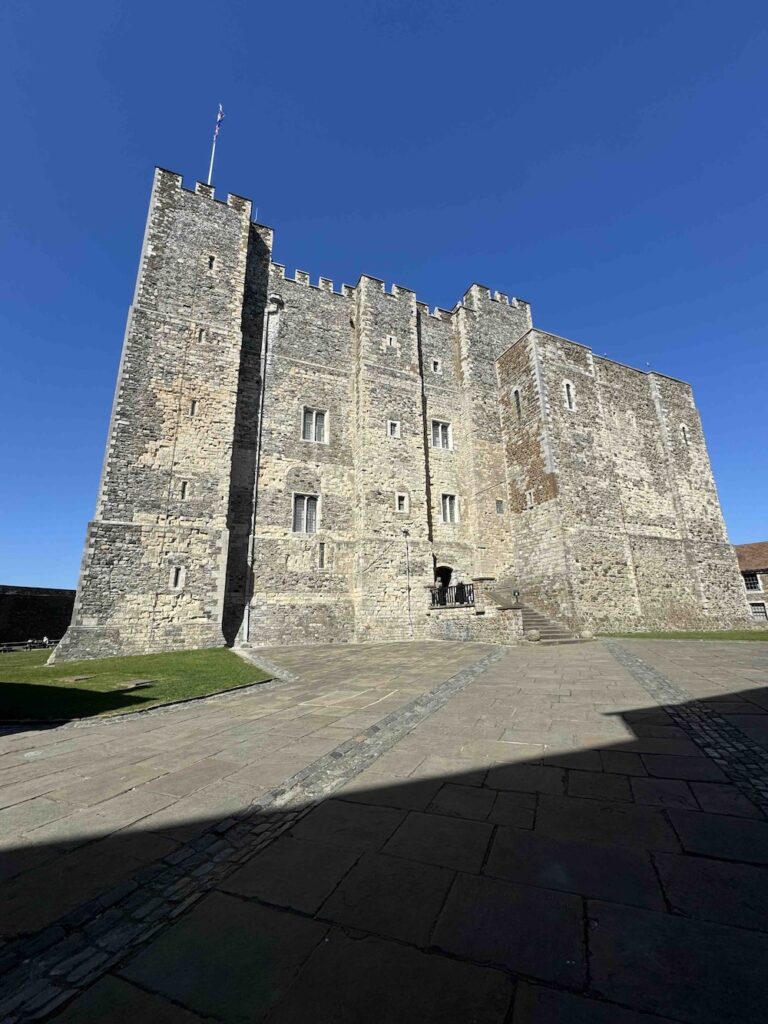
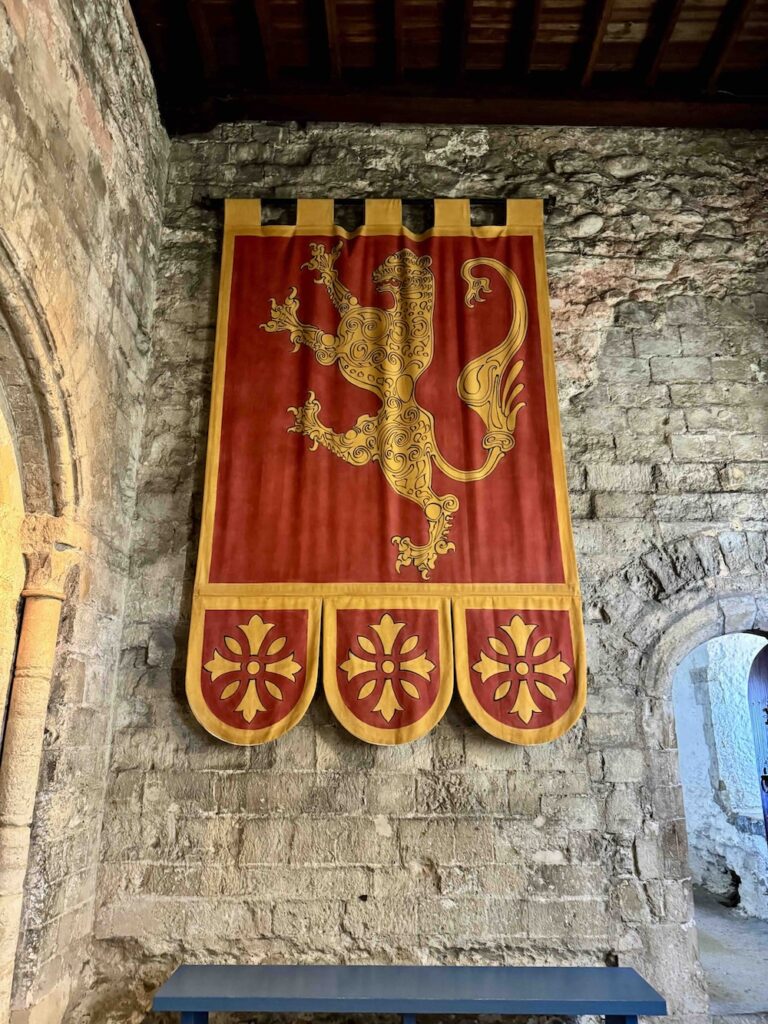

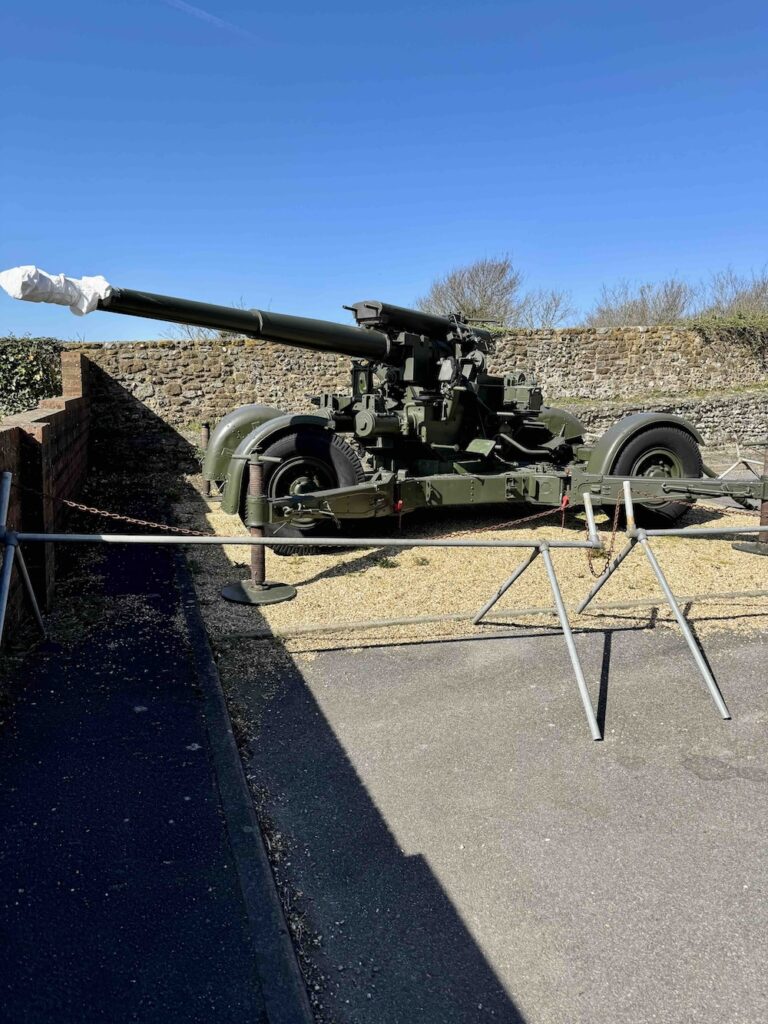
The Great Tower at Dover Castle dates back to 1079 and was built partly to house important guests making the pilgrimage to Canterbury. The design changed over the centuries to suit various needs of the day. Despite the devastation of London by the Nazis during WWII, Dover Castle survived unscathed.
There’s plenty to more do at Dover Castle if you have time. There’s a play area for kids, an escape room, and even accommodations on site if you wish to spend the night. Our visit took us just over 2.5 hours.
White Cliffs of Dover
The famous White Cliffs of Dover were the inspiration for this day trip and thus a must-do for us. Despite Dover Castle being set right on the cliffs, it’s actually a bit annoying to try to get between the two. We opted to walk down the hill from Dover Castle to the edge of town and then back up towards the National Trust Visitor Centre and the start of the cliff walk. It added about a mile to our hike each way to go this route, but we did get to pass through a really pretty street at the bottom of the cliffs.

The National Trust Visitor Centre is open from 10AM-5PM, but the restrooms are available from 9:30AM to 7PM. If you’re driving, you can park at the visitor centre, you have to pay £6 for parking and spaces are limited.
The trails along the cliffs are free to visit. We took an out-and-back route to the South Foreland Lighthouse, staying on the path closest to the cliffs the whole time. The route is about 3.8 miles roundtrip from the visitor centre.
I was concerned when planning our hike that if we were on top of the cliffs we wouldn’t get a good view of the chalky white cliff faces. Thankfully, I was wrong as there are plenty of viewpoints along the hike – I was not disappointed. On a clear day, you can even see France across the English Channel! In face, we were so close to France that my phone plan welcomed me to France. Thankfully European roaming is included in my data plan, but you may want to turn roaming off if it’s not included in yours.
Also, there are many kissing gates on the trail to allow people through but not livestock. We did encounter some cows in our path at one point, but they didn’t seem to mind our presence.

South Foreland Lighthouse
Unfortunately, the lighthouse was closed when we arrived. If you visit during opening hours, you can tour the lighthouse for £8. You can view the lighthouse opening days/times here. There is also a tearoom and toilets at the lighthouse, perfect for a quick break before returning back to the visitor center. To cut your hike in half, you also have the option to take a taxi to the lighthouse and then walk one-way to the visitor center. There’s no parking at the lighthouse.
Langdon Hole
About halfway between the visitor center and the lighthouse is Langdon Hole. From the main trail, a path splits off down towards the beach with a series of narrow switchbacks. At the end of the switchbacks you’ll find a tunnel cut into the chalk cliffs. This hole leads you out towards a ladder you have to climb to reach the rocky beach.

This is a really unique little detour, but you have to time it appropriately. During high tide, the beach and bottom of the ladder are underwater. You should go at least an hour on either side of high tide (click here to view the tide forecast).
Climbing the switchbacks back up to the main trail was the most strenuous part of our hike, but it’s very doable.
Fan Bay Deep Shelter
This WWII era shelter is available to see via guided tour for £15. Part of the tour includes seeing the sound mirrors build during WWI to detect aircraft, a predecessor to sonar technology. Tickets are only sold on-site. However, it’s only open seasonally and we just so happened to be in Dover the day before it opened for the season!
Dover is a Seasonal Destination
While there were other people around on our visit to Dover, it wasn’t very crowded. We didn’t give it much thought until we tried to go to dinner at Wheeler’s Fish & Chips. It was closed when we arrived, and so were most of the other restaurants along the promenade. On a Sunday around 6, even the grocery stores were closed and our dinner options were very limited. We ended up going to Nando’s, which was actually quite packed.
We visited at the end of March, but the city starts to really open up for the season in April and May. Dover is still worth visiting as a day trip from London in the off season, though. We a great day exploring the castle and the cliffs!
Returning to London
After dinner, we walked to the train station and waited for the rail replacement bus. We ended up catching an earlier bus than planned. When we got to Folkestone Central, there was another train heading to London earlier. Our ticket was valid for any super off-peak train, so we hopped on, but thankfully I checked Google Maps before the train left. This was one of the slow trains that would take over 2 hours to get back to London and arrive at a further station from our home. We quickly disembarked and waited 30 minutes for our intended train that got us home faster. Earlier trains don’t always mean earlier arrivals!
Final Thoughts
The White Cliffs of Dover were a place I’d always known about but never realized how easy they were to visit from London. Dover makes for a great day trip from London – there’s so much history in this area, from the middle ages to the the 20th century. Especially on a sunny day, the views of the chalky cliffs overlooking the bright blue English Channel were simply stunning.
Don’t forget to pin this post for future planning!
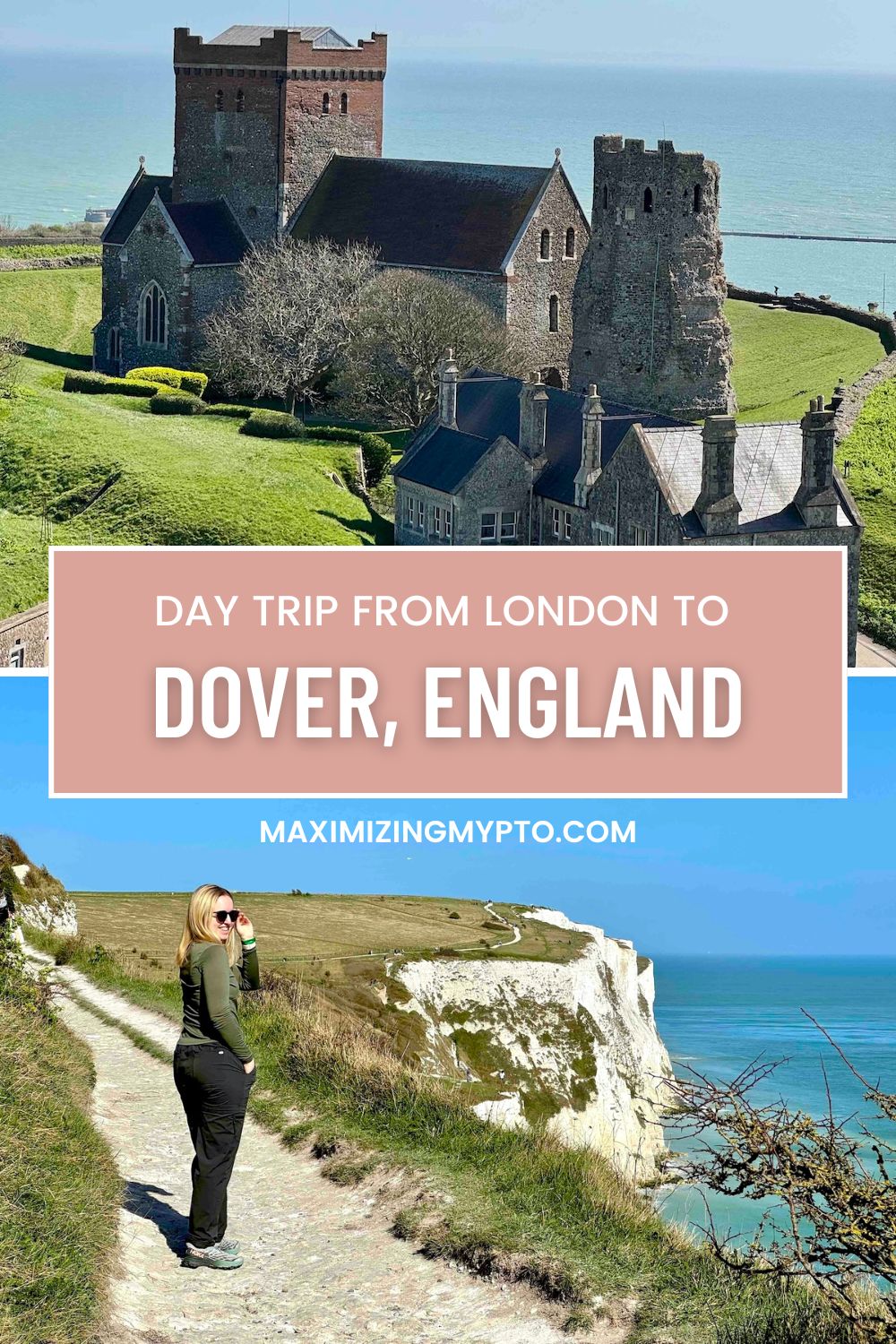
You may also like:

